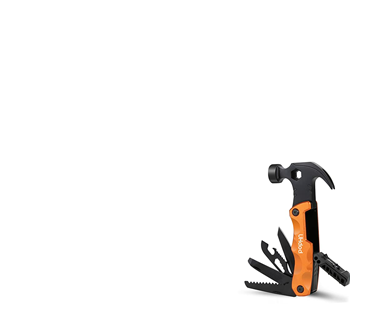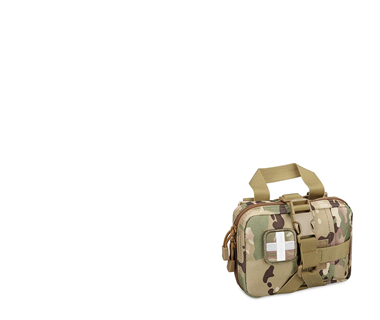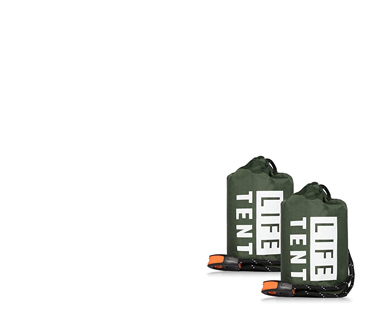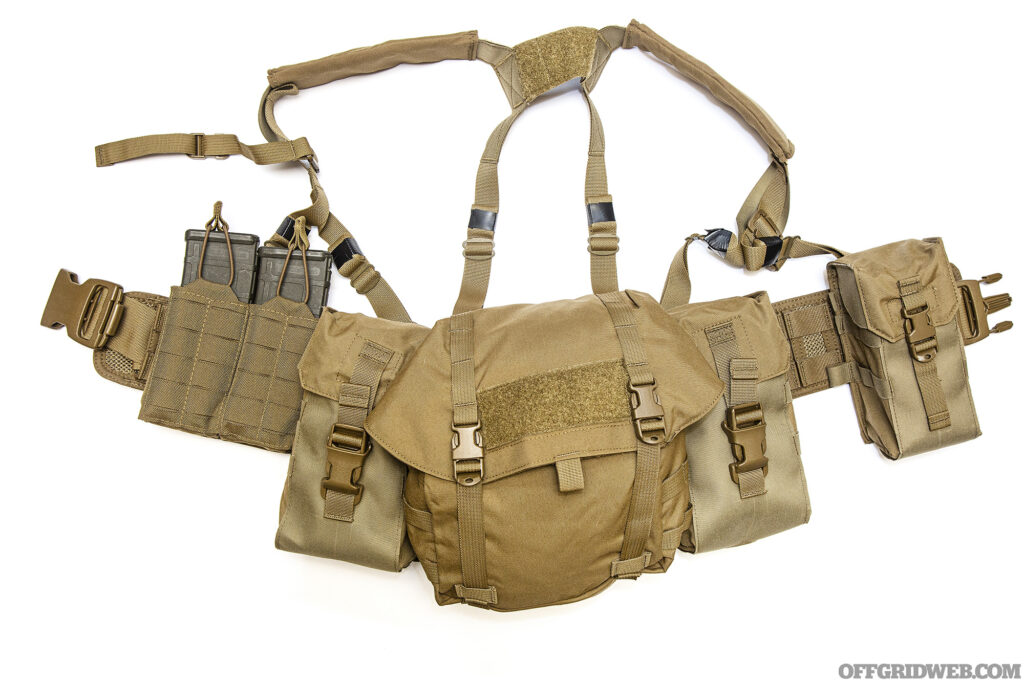Velocity Systems: Jungle Kit Leave a comment
Whether you say “time is a flat circle” or “what’s old is new again,” what we jokingly refer to as tactical fashion trends are indeed a real thing. Just like the Global War On Terror pulled everyone’s attention toward micro chest rigs and CQB, its sunset has redirected the focus of many prepared citizens back toward traditional infantry capabilities. This includes basic patrolling, reconnaissance, and the ability to carry more equipment. On one hand, it’s arguable that the market is simply bored by the endless permutations of tiny chest harnesses and desires other options. But it holds legitimate merit for folks to broaden their horizons beyond the laser-focus on door entry and room clearing. Especially since the overwhelming majority of problems that could be faced by American civilians will not be solvable by kicking in a door and sweeping through a building with a fire team, and kit, they may or may not have.
By contrast, moving overland on foot with enough equipment to be self-sustainable for hours or days doesn’t require a four-man stack, night vision, or short-barreled firearms. In fact, basic patrolling skills don’t require a gun or shooting to be involved at all. You may be trekking to a pre-planned bugout location, making your way back to get help for an injured loved one, or just trying to get a better look at a bad situation in some location that your vehicle can’t get to.
We’re big proponents of the philosophy that application drives equipment selection, and any foot movement over a sizable distance requires different gear than storming a building full of armed bad guys. This is where more traditional load-bearing equipment (LBE) comes in. These kinds of harnesses are also referred to as belt kit (not to be confused with battle belts) or jungle rigs — because they generally emulate the belt-and-suspenders setups used by grunts during the Vietnam War. The original military-issued stuff consisted of a canvas or nylon belt with an attached set of padded suspenders. Later iterations from the ’80s and ’90s included a nylon mesh vest that attached to the belt in place of simple Y-suspenders to increase carriage capacity.
Modern versions have reverted back to the streamlined suspenders and make use of MOLLE/PALS-style webbing to offer better modularity. There aren’t nearly as many gear makers producing these types of rigs, but one — Velocity Systems — produced their jungle rig based on a request from special operations units for a modern LBE setup better suited to long-range patrols than plate carriers or chest rigs. Velocity sent us one of their complete Jungle Rigs to help us examine not only the evolution of these kinds of LBE setups, but also the concept itself and its use for the prepared citizen.
Source
Velocity Systems: Velsyst.com
Bigger Than a Building
The great thing about the Jungle Rig is just how much it can carry — and how easily. The combination of belt and suspenders lets you carry a lot of gear and distribute the burden between hips and shoulders better than a backpack, rucksack, stand-alone battle belt, or a chest rig. The Velocity Systems Jungle Rig comes as a set, with multiple pouch configurations available. It can be had with four rifle pouches that hold three 30-round magazines each, two canteen pouches, and either two general-purpose pouches or a single large butt pack.
Both of these options are also available with 7.62mm rifle pouches that hold two 20-round magazines each. The load-carriage belt has two rows of MOLLE/PALS webbing on a lightweight nylon mesh base with lots of ventilation to keep heat, moisture, and weight to a minimum. The suspenders are lightweight performance fabric in an H-configuration that attaches to the belt at six different points around your waist for maximum support. The MOLLE belt also includes slits located throughout so that you can weave your base belt over the webbing to accommodate holsters or other non-MOLLE accessories.
That’s a total of twelve 30-round magazines, two canteens, and a lot of cargo space left over for whatever else you want to carry — rations, medical equipment, fire-starers, chem lights, a hammock, sleeping mat … your needs and imagination are the limit. Don’t think you need to carry 360 rounds of 5.56mm for your AR? Swap a couple of the mag pouches for whatever other MOLLE pouches you have lying around to make room for more food, water, or survival gear. As a side note, setups like the Jungle Rig might be a great choice for the women in your life, if their build makes chest-mounted load carriage difficult or smaller shoulders make heavy rucks uncomfortable. Regardless of who’s wearing it, this rig is a great solution for when your preparedness problem is bigger than one building or requires more than one or two rooms’ worth of ammo.
What a setup like the Jungle Rig doesn’t account for is armor. You can certainly wear a plate carrier or soft armor, then don the Jungle Rig over the top of it. But even commandos and other light raid forces with a “direct action” mission don’t always wear armor for long-range overland patrols. We’ve heard of units packing plate carriers in their ruck, patrolling “slick” and then armoring up at an objective rally point before initiating an assault on their target. Likewise, if you’re wearing a pack on top of the Jungle Rig, that would be a good way to have armor as an option without wearing it for a multi-mile trek over rough terrain. Of course, depending on what the situation is, you might not need armor at all. In which case, the Jungle Rig is a vastly superior load carriage solution to trying to use a plate carrier with no plates as LBE. (That idea might make you chuckle, but we’ve seen it!)
Too Much of a Good Thing
Gear behaves like a liquid — it’ll take the shape of its container. The bigger your backpack, the more stuff you put it in. No matter how many times we tell ourselves to pack the essentials or travel light, half-filled pouches and packs demand to be stuffed with that last little bit of “just in case” gear, one more survival meal, or a few more extra batteries for the flashlight. In this way, the Jungle Rig enables you to carry a significant amount of gear compared to most chest rigs. This leads us to perhaps the only real “con” we can find with the Velocity Jungle Rig. The included pouches all include polymer loops on the back so that the shoulder harness straps can be looped through them. This is great … if you use them.
But if you wish to take advantage of the modularity of the MOLLE/PALS load-bearing belt by using other pouches, you’ll have to figure out a way to rig the straps in place, as there are no hardpoints to mount the shoulder harness directly to the belt itself. We used a double rifle mag pouch from Wilde Custom Gear on the front left quarter of the belt. This let us have our first two rifle reloads available for fast access, while having three more mags in the included Velocity flap pouch on the opposite side.
This worked well for us from an ammo management standpoint but required us to adjust the pouch so that the top row of MOLLE slots on the back of the pouch rode above the belt, to provide an attachment point for the harness. While it’s not a deal breaker, it’s worth noting that this rig is definitely designed to be used as packaged, and adaptation will require more adaptation to mold it to your needs, if the OEM configuration winds up not being ideal.
All in all, the Velocity Systems Jungle Rig is a thoroughly modernized take on legacy military patrolling harnesses. The streamlined build, use of modern materials, and increased modularity of MOLLE webbing catapults this Vietnam-era load bearing concept into the 21st century, for whatever your needs may be.
Read More
Subscribe to Recoil Offgrid’s free newsletter for more content like this.
HRT LBAC Plate Carrier: The Evolution of Body Armor
EDC Belt, Range Belt, and War Belt Setups
Parashooter Pathfinder: An Adaptable Chest Rig
Hands On: Micro Chest Rigs vs. Heavy Chest Rigs
A Chest Rig for Every Occasion
Editor’s Note: This article has been modified from its original print version for the web.
The post Velocity Systems: Jungle Kit appeared first on RECOIL OFFGRID.




